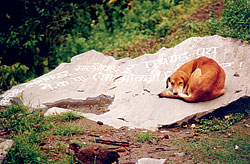 Up here in the remote north of Gorkha district at the base of Mt Manaslu, ten days walk from the nearest road, we should be far away from the Maoist insurgency. The silence and stupendous scenery momentarily lulls us with its tranquility.
Up here in the remote north of Gorkha district at the base of Mt Manaslu, ten days walk from the nearest road, we should be far away from the Maoist insurgency. The silence and stupendous scenery momentarily lulls us with its tranquility. But the silence of these villages is the silence of fear. You suddenly realise that there is no laughter of children greeting strangers walking into town, no curious villagers chit-chatting on the trails. Fear stalks the valley of the Budi Gandaki, even this high up near the Chinese border.

Driven up the valley by the action of the security forces, armed Maoist guerrillas roam the village trails and train in the jungles. The nearest army base is eight days walk away at Arughat, and the Maoists here don't even bother to hide.
Samagaun and the villages of Shyo and Lho are located high in the Manaslu region, directly north of the areas of Gorkha district which have been Maoist strongholds. There is one way in and one way out, and the guerrillas have their bases and training camps in the thick coniferous forests on either side of the river. There used to be two police stations at Jagat and Namrung, but they were blown up by Maoists in late May.
In a monastery courtyard in Shyo, Gyalmo had just started telling us: "People do not treat strangers as they used to in the past." Just then his younger brother Pema shouted from the house, "Get inside, quick, inside. Maobadis are coming." (Both names have been changed to protect the brothers' identity.)
Later, we found out that a rebel squad led by Bhakti Lamichhane, known as Comrade Sameer, had come up to find out who had flown in on the helicopter. The villagers apparently told the Maoists that it was a group of monks who had come from Kathmandu to paint the monastery.
At Samdo, 3,900 m above sea level, the local lodge owner told us the last time the Maoists came was in June. "I drank an entire bottle of Chinese liquor to fortify myself," he said. They had come to ask him to feed some of their comrades. "Of course I fed them, what can you do when they have guns?"
 Things get more tense as you move south along the swollen Budi Gandaki. The deep gorges and cliffs serve as perfect hideouts, and the security forces avoid them for fear of ambush. "We don't have an idea of where they may be but can sense them all around us," a shopkeeper in Philim told us. "They come when they want, ask us for food and supplies and then leave after painting slogans on our houses." Most villagers are afraid the army will come up and mistake them for Maoist sympathisers because of the slogans.
Things get more tense as you move south along the swollen Budi Gandaki. The deep gorges and cliffs serve as perfect hideouts, and the security forces avoid them for fear of ambush. "We don't have an idea of where they may be but can sense them all around us," a shopkeeper in Philim told us. "They come when they want, ask us for food and supplies and then leave after painting slogans on our houses." Most villagers are afraid the army will come up and mistake them for Maoist sympathisers because of the slogans. "One of them told me, Ama don't ever erase this slogan," a 60-year-old grandmother told us in Jagat. "Otherwise you will be killed." Now she fears she will be killed if she does, and killed if she doesn't. The red scrawl on her wall reads: "Withdraw the anti-terrorist law, and end the military offensive." The slogans are everywhere on the road to Arughat: on destroyed public buildings, the sides of homes, on cliffsides, on bridges.
The villagers are so terrified of forced recruitment by the Maoists or retaliation by the security forces, that many young men have fled the region. There are very few teachers, or anyone who can read and write, left.
"If you don't agree with them, you get killed. So the safe option is to get out," admitted one village elder.
Here in the north, villagers suspect any lowland "Rongba" of being a Maoist and keep away from them. "I spent the whole night in the jungle with my wife when I heard that the Maoists had come to our village," a local in Syala told us.
Soldiers go out on patrol from the Royal Nepal Army camp at Arughat, and venture as far out as Lapu, one day north. The regions beyond are already rife with rumours about what the soldiers do. "Some teachers at Lapu were beaten up, and so was a hotelier who later fled to India," a teacher told us. For their part, the Maoists killed a hotel owner in Armala on suspicion of being an informant.
Northern Gorkha is a food deficit area, but no food has gone up for the past three months. The villagers have the current potato crop to last them till new supplies are brought down from Tibet. The lawlessness has also increased timber poaching, and hundreds of yaks carry Nepali logs being smuggled into China.


